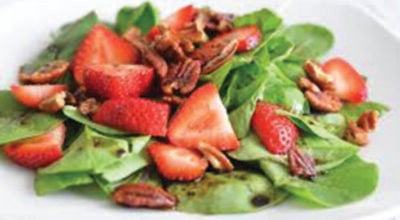The Literary Corner: Renegade Writer’s Guild
Published 9:31 am Thursday, July 12, 2018
“Does this taste funny to you?”
By Mike Gowen
Ok, you’ve probably heard the joke about the two cannibals who were eating the clown when one turns to the other and asks, “Does this taste funny to you?” My wife and I weren’t eating a clown, rather, we were enjoying a turkey dinner complete with gravy and dressing. I was quite proud of my efforts when my wife took a bite of the dressing, winced, and a scowl appeared across her face. “This doesn’t taste right,” she said while trying to remain ladylike and spit the dressing out simultaneously. “What?” I exclaimed, my pride hurt that something I prepared was questioned. Then, I tried it, and no, I wasn’t close to being gentlemanly when I expelled it back onto my plate.
A little private detective work ensued, and I discovered the expiration date on the stuffing was something in 2003, B.C., I think. I didn’t know stuffing could go bad. After all, it’s just… stuff. Rest assured it can, however, and does. After the shock wore off of preparing stuffing three years past its expiration date, we began to wonder how we ignored this box in the cabinet for three years now. If we weren’t going to use it, why did we buy it?
“You probably had a coupon,” my wife suggested. Ah, there it is, the infamous coupon zinger hurled at me. Luckily, we’ve been married a few years now, and I know when to duck. Okay, I admit I clip coupons. I admit that on more than one occasion we’ve donated items to food banks that I had purchased because I had a coupon. My wife hates the grocery store. I love it. I get a rush when I go through the checkout and realize I saved $1.45. Hey, that’s almost enough for a loaf of bread. On those triple coupon weekends, forget about it. I’m right there with the rest of the coupon crazies fighting for that last can of Spam.
It drives my wife crazy, but since she doesn’t like to grocery shop, she lets me have my fun. I did, however, make a note to myself. The next time I prepare dinner… I’m checking the expiration dates.
“Getting My Attention”
By Kevin F. Wishon
Standing behind the metal turning lathe, I looked straight into the eyes of the operator and fellow student. His face was pale. Apparently, he was in shock. Prior to this day, I thought the phrase “pale as a ghost” was merely a literary expression. I had never seen the blood drain from a person’s face before.
“Are you okay?” I asked him, but my classmate said nothing. After a few moments, he turned the lathe off and stepped back from the machine. Bending over, he pulled his knee-length shorts up and examined his inner thigh. There, he located a darkning bruise the size of a fifty-cent piece on the inside of his left leg. Satisfied he was not seriously injured, he turned and retrieved the chuck key lying on the floor several feet behind him. He returned for two more classes, but afterward, I never saw him again.
A metal turning lathe is a machine used to manufacture parts by rotating metal rod while simultaneously cutting away layers of the material to a specific depth and smoothness. A chuck key is a T-shaped wrench used to open and close the jaws of the lathe chuck. The lathe chuck grips and holds the metal rod firmly allowing its rotation to reach high rates of speed.
The CNC/Machining class I attended was a fire hose of information and directions. Despite this, the first day we started training on the metal turning lathes we were warned to always remove the chuck key before starting the lathe. Failing to do so could result in injury or death if the machine slung a chuck key towards anyone standing nearby. Of course, there was a guard if used that would remind the operator to remove the wrench. However, inexperienced students generally felt it hindered them from clearly seeing the machining process so the guard was used infrequently.
Although I haven’t seen my classmate since this occurrence, I’m sure if I did, he would remember the moment well. I know I do. It has haunted me for years and sharpened my respect for machinery. To say I never left a chuck key in the lathe chuck would be dishonest. I did on two separate occasions when I was tired and not paying attention. Thankfully both times, the chuck key was slung underneath the machine sparing me of injury. While I’m grateful neither he nor I were seriously injured, the near misses I witnessed reminded me just how close the potential for danger is around us.
“Farmington Cookbook”
By Marie Craig
Recently, I was able to borrow a really interesting book that was written in 1924. The subtitle was “Right and Ready Recipes.” The Farmington Ladies Aid Society of M.E. [Methodist Episcopal] Church South, Farmington, compiled and published this wonderful cookbook. The minister at that time was Rev. C.M. McKinney.
The Aid Society Officers were Mrs. F.H. Bahnson, Mrs. L.J. Horne, Mrs. Jess Smith, and Mrs. T.H. Nicholson. The Cook Book Committee chairman was Mrs. Jess Smith. Other members were Mrs. Mable Redman, Mrs. R.C. Brown, Mrs. C.C. Williams, Mrs. M.B. Brock, Mrs. Leo Brock, Mrs. L.J. Horne, Mrs. Herbert Nicholson, Mrs. F.H. Bahnson, Mrs. Marian Johnson, Mrs. J.A. Bahnson, Mrs. W.E. Kennen, Mrs. C.A. Hartman, and Mrs. O.R. Allen.
There were 21 categories listed. The most interesting one was “Invalid Cooking.” On the two pages of that section there were nine recipes by Mrs. Estelle Johnson, R.N. They ranged from Albumen Water to Invalid Sandwich. She also gave the advice, “Do not put pepper in food for small children.” Another recipe listed for the sick was Ginger Tea: One t. molasses, ½ t. ginger, ½ c. boiling water, ½ c. milk. Other women listed recipes and suggestions for curing the sick.
In the Miscellaneous Section, one recipe was “To Cure Joint Meat—Sprinkle meat with saltpeter the same day it is killed, as soon as hung up, smoke with green hickory chips for several days 2 or 3 hrs. each day.”
“To take the Lettering Out of Flour Sacks, Etc.—Saturate with coal oil, and lay by for a while, then wash as usual.”
“To Kindle Fires.—Corn cobs soaked in coal oil [kerosene] make the best kindling you can find, keep ½ doz. standing in a can partly full of oil, use 1 at a time.”
“A layer of absorbent cotton in the mouth of fruit cans is an excellent preventative against mold. If mold should form, it will cling to the cotton and leave the fruit clean.”
Interesting recipes were for Scripture Cake [ingredients mentioned in the Bible], Nasturtium Sandwiches, Watermelon Cake, Pie-plant [rhubarb] Pie, and Grape Catsup. One recipe called for Jello. Research showed me that it was first created in 1897, in LeRoy, N.Y., by a carpenter and cough syrup manufacturer.
There were photographs of the church and the parsonage in Farmington. There were 65 ads on 34 pages. Kurfees Paint Store in Mocksville described their product as being 80% Pure Carbonate Lead and 20% Pure Zinc Oxide. Phone numbers listed in the stores were single digits. Ads ranged from stores to doctors to banks and filling stations. The ad for the Winston-Salem Journal listed an annual price of $6.50.
Many things have changed in these 94 years since the cookbook was printed. Several things have not changed: people still like to eat, share recipes, and give advice. Jello is still going strong. People work hard, establish businesses, and hope to make a profit.





